Exposition en ligne |
Imprimerie arménienne dans l'Empire ottoman

Les Arméniens furent parmi les premiers à utiliser l'invention de Gutenberg. À partir de 1512, partout dans le monde, où il y avait des communautés arméniennes ont été ouvertes des typographies et ont été imprimés des livres en langue arménienne. L'Empire ottoman a été également impliqué dans ce processus. Le premier livre en arménien a été imprimé à Constantinople en 1567. Au fil du temps, Constantinople est devenu l'un des principaux centres de l'impression arménienne et a conservé ce rôle jusqu'au début du 20ème siècle.
Après une courte activité typographique d'Abgar Tokatetsi (1568 - 1569) et Yeremia Kyomurjian (1677-1678) à Constantinople, au 17ème siècle ont été fondées les maisons d'édition de Sargis Evdokatsi, de Grigor Marzvantsi et d’Astvatsatur Konstandnupolsetsi, qui avaient une activité typographique pour une longue période. Parmi les célèbres éditeurs arméniens occidentaux étaient également Pogos Arapian, Sargis Dpir, Chnchin Hovhannes et d’autres. Jusqu'en 1800 seulement à Constantinople ont été publiés environ 350 livres arméniens.
Avec les publications religieuse et morale ont été également imprimés des livres historique, artistique , éducatif, scientifique etc, comme en grabar (vieil arménien), ainsi qu’en arménien moderne, y compris la littérature traduite.
Des maisons d'édition arméniennes ont été établies à Smyrne, à Armash, Van, Mouch, Bursa, Adana, Adrianapole, Adabazar, Konya, Nicomédie, Samsun, Karin, Erznka, Evdokia, Kharberd, Amasia, Marzvan, Ayntap et ailleurs.
Les maisons d'édition arméniennes ont cessé de fonctionner pendant le génocide en Arménie occidentale et dans les villes de l’Empire ottoman ou il y avait beaucoup d’Arméniens. Au cours de ces années, des centaines de maisons d'édition, des bibliothèques et des dépôts de manuscrits anciens ont été détruits, des dizaines de milliers de livres arméniens ont été brûlés.
 From History of Armenian Printing Houses of Constantinople: block letters and template-clichés.
From History of Armenian Printing Houses of Constantinople: block letters and template-clichés.
 From History of Armenian Printing Houses of Constantinople: block letters and template-clichés.
From History of Armenian Printing Houses of Constantinople: block letters and template-clichés.
 "St. John’s Book of Revelation and Interpretation", Constantinople, 1700.
"St. John’s Book of Revelation and Interpretation", Constantinople, 1700.
 "Small and Nice Song-book, Songs Sung by Wise Poets", Constantinople, 1700.
"Small and Nice Song-book, Songs Sung by Wise Poets", Constantinople, 1700.
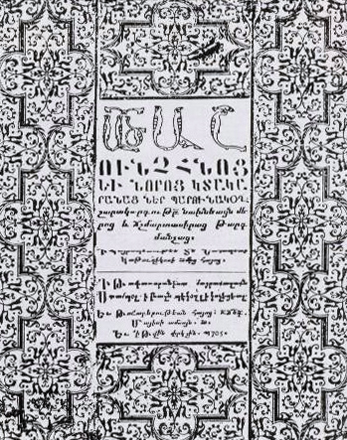 "The Bible", Constantinople, the Printing House of Petros Latinatsi, 1705.
"The Bible", Constantinople, the Printing House of Petros Latinatsi, 1705.
 "Yasmavurk", Constantinople, the Printing House of Marzvantsi, 1706.
"Yasmavurk", Constantinople, the Printing House of Marzvantsi, 1706.
 Agatangeghos, "History of Armenians", Constantinople, the Printing House of Grigor Marzvantsi, 1709.
Agatangeghos, "History of Armenians", Constantinople, the Printing House of Grigor Marzvantsi, 1709.
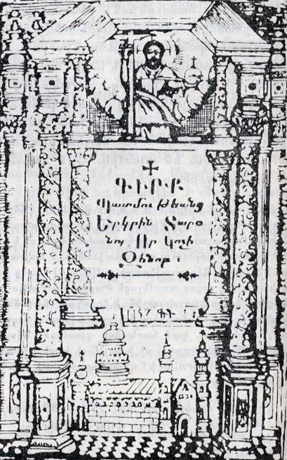 Zenob Glak, "Book about the History of Taron", Constantinople, the Printing House of Grigor Marzvantsi, 1719.
Zenob Glak, "Book about the History of Taron", Constantinople, the Printing House of Grigor Marzvantsi, 1719.
 Grigor Narekatsi, "Prayer Book", Constantinople, the Printing House of Hovhannes and Poghos, 1782.
Grigor Narekatsi, "Prayer Book", Constantinople, the Printing House of Hovhannes and Poghos, 1782.
 "Book of Life for Children: Religious Songs, Precepts and Real Histories", Smyrna, Homan Hallok Printing House, 1838.
"Book of Life for Children: Religious Songs, Precepts and Real Histories", Smyrna, Homan Hallok Printing House, 1838.
 "Pedagogue that Gives Useful Talks to Educate Boys", Smyrna, Homan Hallok Printing House1839.
"Pedagogue that Gives Useful Talks to Educate Boys", Smyrna, Homan Hallok Printing House1839.
 "The Life of Patriarchs and Prophets (Conversations with Useful Precepts and Examples)", Smyrna, Homan Hallok Printing House, 1839.
"The Life of Patriarchs and Prophets (Conversations with Useful Precepts and Examples)", Smyrna, Homan Hallok Printing House, 1839.
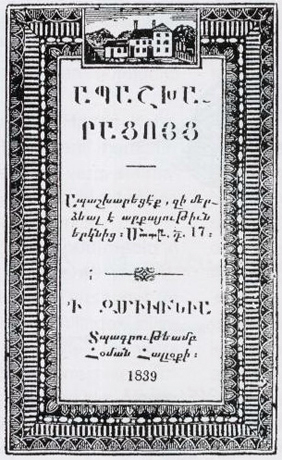 "Book of Confession", Smyrna, Homan Hallok Printing House, 1839.
"Book of Confession", Smyrna, Homan Hallok Printing House, 1839.
 "Song-book of the Armenian St. Church", Hortagyugh, the Printing House of Poghos Arapian’s sons.
"Song-book of the Armenian St. Church", Hortagyugh, the Printing House of Poghos Arapian’s sons.
 "Mother Taking Care of Her Child", Translated from the Original English text, Smyrna, Kulielmous Krift’s Printing House, 1840.
"Mother Taking Care of Her Child", Translated from the Original English text, Smyrna, Kulielmous Krift’s Printing House, 1840.
 "Armenians’ National Constitution", Constantinople, 1863.
"Armenians’ National Constitution", Constantinople, 1863.
 Carlo Goldoni, "The Virtue of Bamelatsi", Comedy, Smyrna, Teteian Printing House, 1866.
Carlo Goldoni, "The Virtue of Bamelatsi", Comedy, Smyrna, Teteian Printing House, 1866.
 "Grammar Textbook for Elementary Schools", Constantinople, Hovhannes Terotents’ Printing House, 1870.
"Grammar Textbook for Elementary Schools", Constantinople, Hovhannes Terotents’ Printing House, 1870.
 "Women’s Secret, Translated from a 400-year Old Manuscript, by Armenian Archbishop Hovhannes", Constantinople, 1876.
"Women’s Secret, Translated from a 400-year Old Manuscript, by Armenian Archbishop Hovhannes", Constantinople, 1876.
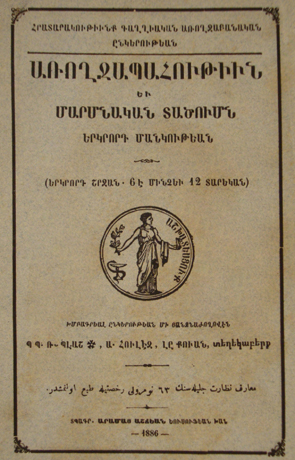 "Health and Physical Care for the Youth", Aram Ashjian's Printing House, 1886.
"Health and Physical Care for the Youth", Aram Ashjian's Printing House, 1886.
 Minas G. Minasian, "Musical Education According to the European Norms", Constantinople, Hovsep Galafian's Printing House, 1887.
Minas G. Minasian, "Musical Education According to the European Norms", Constantinople, Hovsep Galafian's Printing House, 1887.
 Priest Hovhannes Mavian, "Principal of Moral Education", Nicomedia, Armash of Van Printing House, 1889.
Priest Hovhannes Mavian, "Principal of Moral Education", Nicomedia, Armash of Van Printing House, 1889.
 "Triennial Reference Book of the Eastern Economic Union, Established on March 9, 1886", Constantinople, G. Paghtatlian Printing House, 1889.
"Triennial Reference Book of the Eastern Economic Union, Established on March 9, 1886", Constantinople, G. Paghtatlian Printing House, 1889.
 Levon Mkrtchian, "Marriage Problems; Man - Woman", Constantinople, 1894.
Levon Mkrtchian, "Marriage Problems; Man - Woman", Constantinople, 1894.
 M. Mamurian, "General History for Schools in Brief", II volume. Second edition, Smyrna, Mamurian Printing House, 1899.
M. Mamurian, "General History for Schools in Brief", II volume. Second edition, Smyrna, Mamurian Printing House, 1899.
 Herman Glenke, "Female as a Virgin, Hygiene of Physical and Spiritual Health of Virgin Life", translation from German by M.K. Nazikian, Y. Mateosian Printing House, Constantinople, 1901.
Herman Glenke, "Female as a Virgin, Hygiene of Physical and Spiritual Health of Virgin Life", translation from German by M.K. Nazikian, Y. Mateosian Printing House, Constantinople, 1901.
 K. S. Tukhmanian, "Commercial and Economic World", Smyrna, Mamurian Printing House, 1902.
K. S. Tukhmanian, "Commercial and Economic World", Smyrna, Mamurian Printing House, 1902.
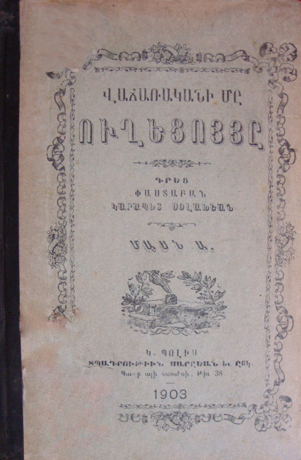 Karapet Solakhian, "Reference Book of a Merchant", Part A, Constantinople, Sarian and Friends Printing House, 1903.
Karapet Solakhian, "Reference Book of a Merchant", Part A, Constantinople, Sarian and Friends Printing House, 1903.
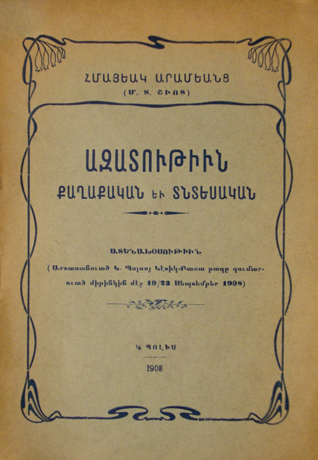 Hmayak Aramiants, "Political and Economic Freedom", Constantinople, 1908.
Hmayak Aramiants, "Political and Economic Freedom", Constantinople, 1908.
 Malkhas, "Current Starvation and Its Causes", Trebizond, Meshveret Printing House, 1909.
Malkhas, "Current Starvation and Its Causes", Trebizond, Meshveret Printing House, 1909.
 Y.G.M., "Private History of the Armenian Wealthy", Constantinople, O. Arzuman Printing House, 1910.
Y.G.M., "Private History of the Armenian Wealthy", Constantinople, O. Arzuman Printing House, 1910.
 "Code of Rules for Non-Muslim Elements’ Enlistment", translation by K. Solakhian, Constantinople, O. Arzuman Printing House, 1910.
"Code of Rules for Non-Muslim Elements’ Enlistment", translation by K. Solakhian, Constantinople, O. Arzuman Printing House, 1910.
 R. Asasian, "Little Hero: From the Turkish Life", Evdokia, 1911.
R. Asasian, "Little Hero: From the Turkish Life", Evdokia, 1911.
 Sarah Nelson Carter, "For the Sake of Love and Mercy: Love Animals and Adore Them", Constantinople, O. Arzuman Printing House, 1911.
Sarah Nelson Carter, "For the Sake of Love and Mercy: Love Animals and Adore Them", Constantinople, O. Arzuman Printing House, 1911.
 Hovhannes Hakobian, "Civic Education", Constantinople, Y. Mateosian Printing House, Constantinople, 1911.
Hovhannes Hakobian, "Civic Education", Constantinople, Y. Mateosian Printing House, Constantinople, 1911.
 Tiran Muradian, "Guide for Reading and Translation from English", year B, Constantinople, 1911.
Tiran Muradian, "Guide for Reading and Translation from English", year B, Constantinople, 1911.
 G. Gojaian, "Armenian Sighs: Patriotic and Religious poems", Marzvan, Nerso and Srapian Printing House, 1911.
G. Gojaian, "Armenian Sighs: Patriotic and Religious poems", Marzvan, Nerso and Srapian Printing House, 1911.
 Mamikon Varjapetian, "Conversations: Review of Some Significant Issues of the Armenian Reality, Practical Direction Pointing out to the Mistakes and Solutions", Marzvan, Nerso and Srapian Printing House, 1911.
Mamikon Varjapetian, "Conversations: Review of Some Significant Issues of the Armenian Reality, Practical Direction Pointing out to the Mistakes and Solutions", Marzvan, Nerso and Srapian Printing House, 1911.
 Gh. Meloian, "Pictures", book A, Kirason, Petak Printing House, 1912.
Gh. Meloian, "Pictures", book A, Kirason, Petak Printing House, 1912.
 G. Vardapetian, "Topographic Geography of National Schools of Amasya", Prepared for the First Two 2 Months of III form, for 1911-1912, Amasya, Pokr Hayk Printing House, 1912.
G. Vardapetian, "Topographic Geography of National Schools of Amasya", Prepared for the First Two 2 Months of III form, for 1911-1912, Amasya, Pokr Hayk Printing House, 1912.
 "Program and Code of Rules of the Priesthood Union of Constantinople", Constantinople, 1912
"Program and Code of Rules of the Priesthood Union of Constantinople", Constantinople, 1912
 A. Totel, "Mousses or Darwin", translated by Gurgen N. Papazian, Kirason, Petak Printing House, 1912.
A. Totel, "Mousses or Darwin", translated by Gurgen N. Papazian, Kirason, Petak Printing House, 1912.
 "Pocket Book of New Patriotic Songs", Marzvan, Nerso and Srapian Printing House, 1913.
"Pocket Book of New Patriotic Songs", Marzvan, Nerso and Srapian Printing House, 1913.
 "Life Planned by God", translation from English, Kharberd, Eprat Printing House, 1913.
"Life Planned by God", translation from English, Kharberd, Eprat Printing House, 1913.
 S. Piperjian, "New Political, Statistical and Commercial Pocket Atlas", Constantinople, Sanjagjian Printing House, 1914.
S. Piperjian, "New Political, Statistical and Commercial Pocket Atlas", Constantinople, Sanjagjian Printing House, 1914.
 Tigran Bolatian, "7 String Lyre", Sebastia, Kabira K. A. Parsamian Printing House, 1914.
Tigran Bolatian, "7 String Lyre", Sebastia, Kabira K. A. Parsamian Printing House, 1914.
 "Program and Code of Rules of Shavarshian Student Union at Anatolia College", Marzvan, Anatolia Printing House (Y. M. Srapian), 1915.
"Program and Code of Rules of Shavarshian Student Union at Anatolia College", Marzvan, Anatolia Printing House (Y. M. Srapian), 1915.
 Alper Lavinia, "Musical Education", translation by Mihran Tarentelian, Constantinople, 1919.
Alper Lavinia, "Musical Education", translation by Mihran Tarentelian, Constantinople, 1919.
 Levon S. Taragjian, "Fulfilled Prophecy", Adana, Hay Dzayn Printing House, 1919.
Levon S. Taragjian, "Fulfilled Prophecy", Adana, Hay Dzayn Printing House, 1919.
 Manuscript of Reports, "Gevorg Arslanian", Adana, Cilicia Printing House, 1920.
Manuscript of Reports, "Gevorg Arslanian", Adana, Cilicia Printing House, 1920.
|
|
|
DONATE |
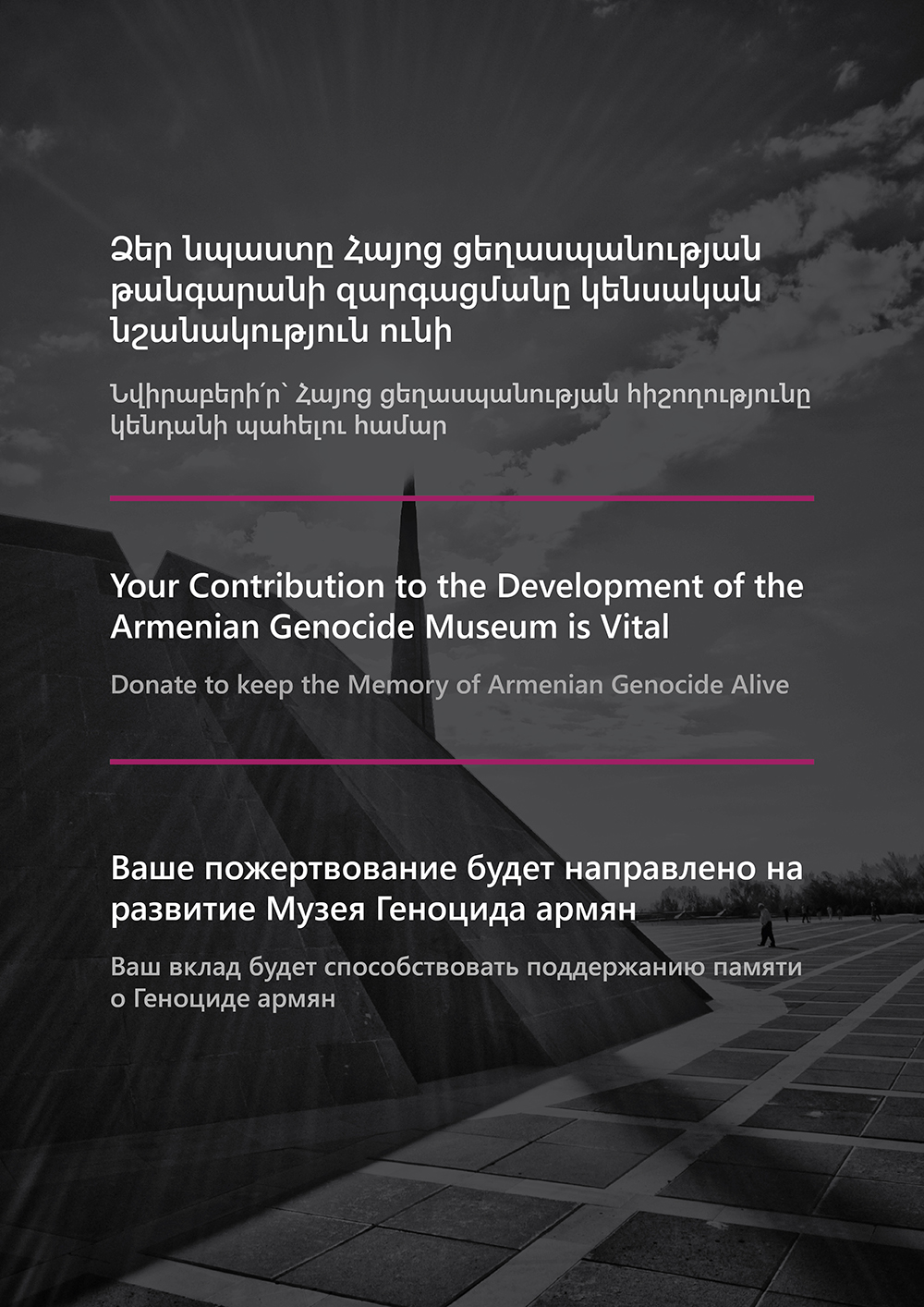
Pour garder la mémoire du génocide des Arméniens
Projets spéciaux mis en œuvre par la Fondation « Musée-institut du génocide des Arméniens »
|
LIBRAIRIE DU MIGA |
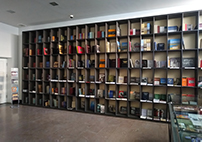
"Monde des livres" du Musée-Institut de génocide des Arméniens
|
TOUMANIAN 150 |

|
TRANSFÈRE TA MÉMOIRE |
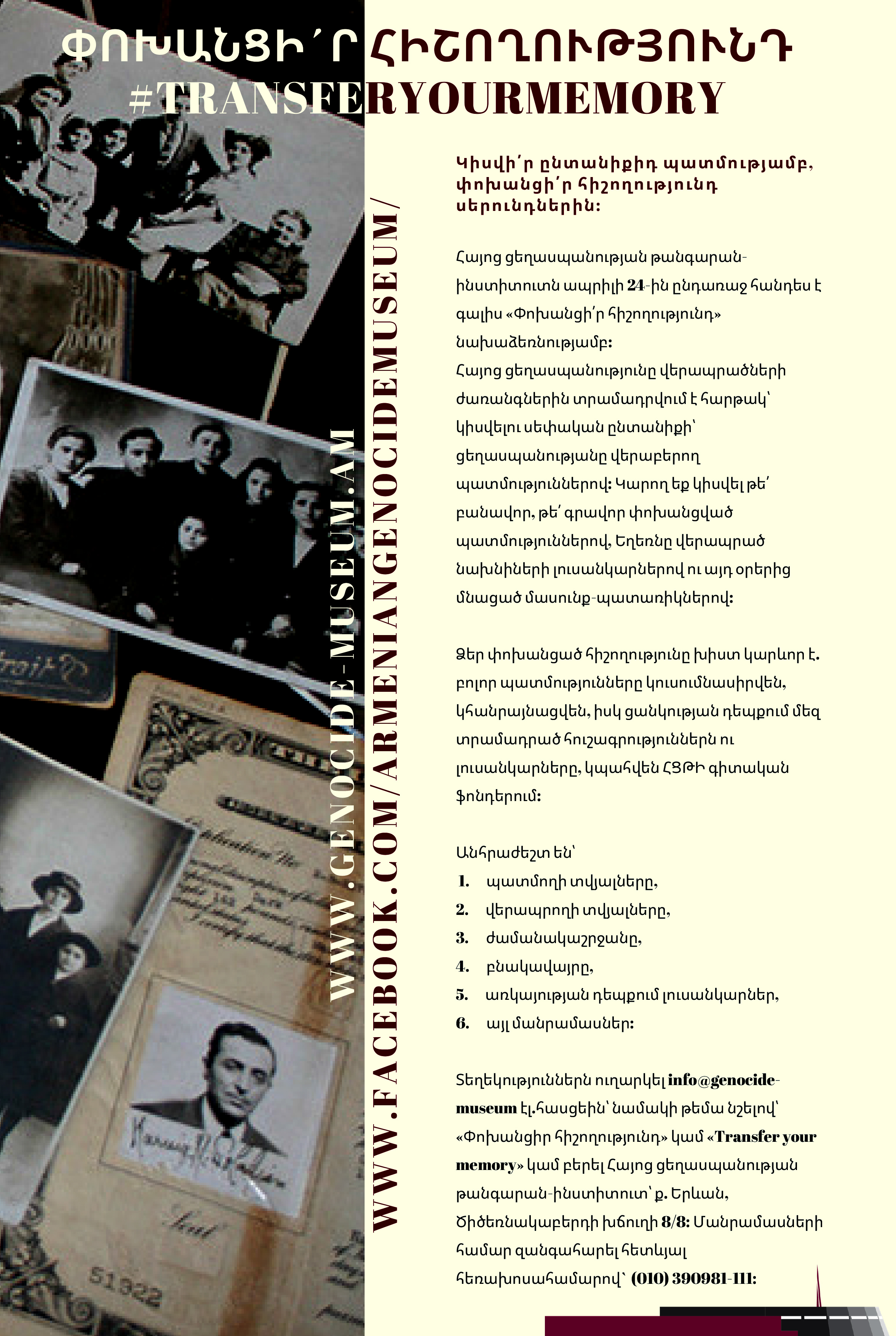
Partage l’histoire de ta famille,
transfère ta mémoire aux générations
À l’encontre du 24 avril, le Musée-Institut de Génocide des Arméniens a lancé l’initiative «Transfère ta mémoire».
|
|





